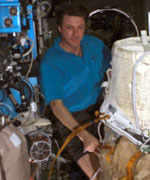
Image credit: NASA
A new NASA-funded study revealed how bone loss increases the risk of injuries, highlighting the need for additional measures to ensure the health of spacecraft crews.The study provides new information about bone loss caused by prolonged spaceflight. The study is in the online version of the Journal of Bone and Mineral Research.
The research team was from the University of California San Francisco (UCSF) and Baylor College of Medicine, Houston. The team used three-dimensional X-ray computed tomography (CT) to study the effect of prolonged weightlessness on the bone mineral density and structure of the hip in a group of 14 American and Russian International Space Station crewmembers. The crewmembers spent from four to six months onboard the Station. The research suggests additional conditioning exercises and other countermeasures may be necessary to prevent bone mineral loss.
“This study underlines the importance of continuing to develop countermeasures to preserve musculoskeletal conditioning in long-duration space travelers,” said Guy Fogleman, director of Bioastronautics Research in NASA’s Office of Biological and Physical Research, Washington. “Results of this research, which may aid people on Earth who suffer for similar conditions including osteoporosis, are being shared with the medical community,” he added.
This study is the first to use CT imaging to three-dimensionally quantify spaceflight-related bone loss in the hip and to estimate changes in hipbone strength. Previous studies used a two-dimensional imaging technology called dual X-ray absorptiometry.
The CT measurements in the hip were performed pre- and post-flight to measure bone loss in the porous bone in the interior of the hip and in the dense outer shell of the hipbone. On average, the Station crew lost interior bone at a rate of 2.2 to 2.7 percent for each month in space and outer bone at a rate of 1.6 to 1.7 percent per month.
“Our study demonstrates that bone loss occurs in the Space Station crewmembers at a rate comparable to that observed almost a decade before in the crew of the Russian Mir spacecraft,” said Thomas Lang, UCSF associate professor of radiology and principal investigator on the study. “The lack of clear progress in the interval between Mir and Station missions indicates a need for continued efforts to improve musculoskeletal conditioning regimens during longer space missions, such as those proposed for the moon and Mars,” Lang said.
The investigators used information from the CT images to estimate changes in the strength of the hipbone. They found on average the hipbone strength declined by 2.5 percent for each month of flight. Since the amount of bone loss increases with mission length, crewmembers on multiyear explorations may face increased risk of fracture upon return to Earth gravity. In addition, those who do not recover the lost bone may be at increased risk of fracture as they age.
The researchers also analyzed loss of density in vertebrae (back bones). Vertebrae, along with the hip, are the skeletal sites associated most with serious osteoporotic fractures in the elderly. The study found on average, the Station crew lost vertebral bone at a rate of 0.8 to 0.9 percent per month, which was consistent with data from earlier long-duration missions.
To view the study on the Internet, visit:
For information about space research on the Internet, visit:
http://spaceresearch.nasa.gov/
Original Source: NASA News Release
